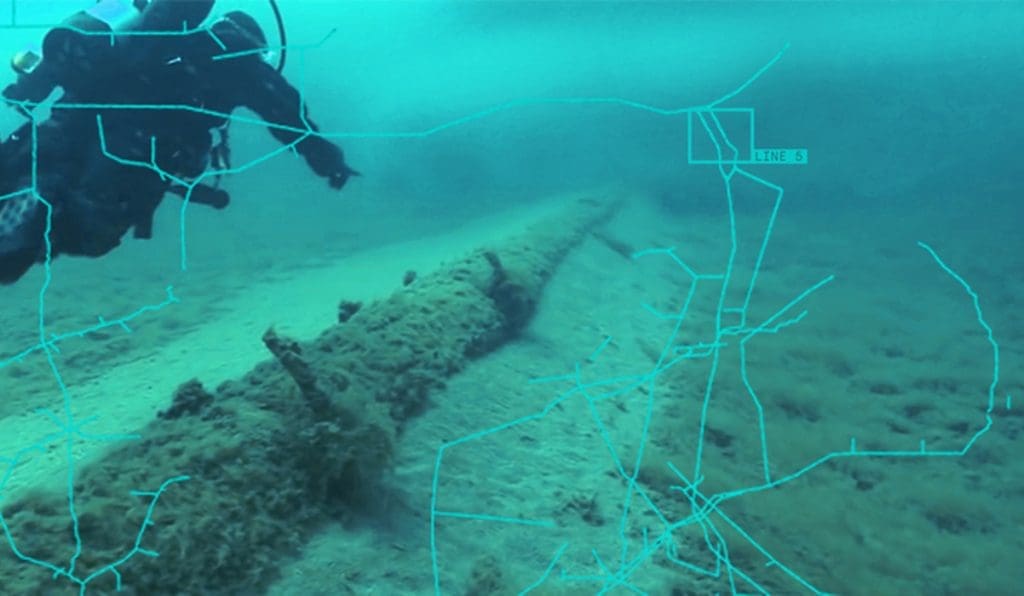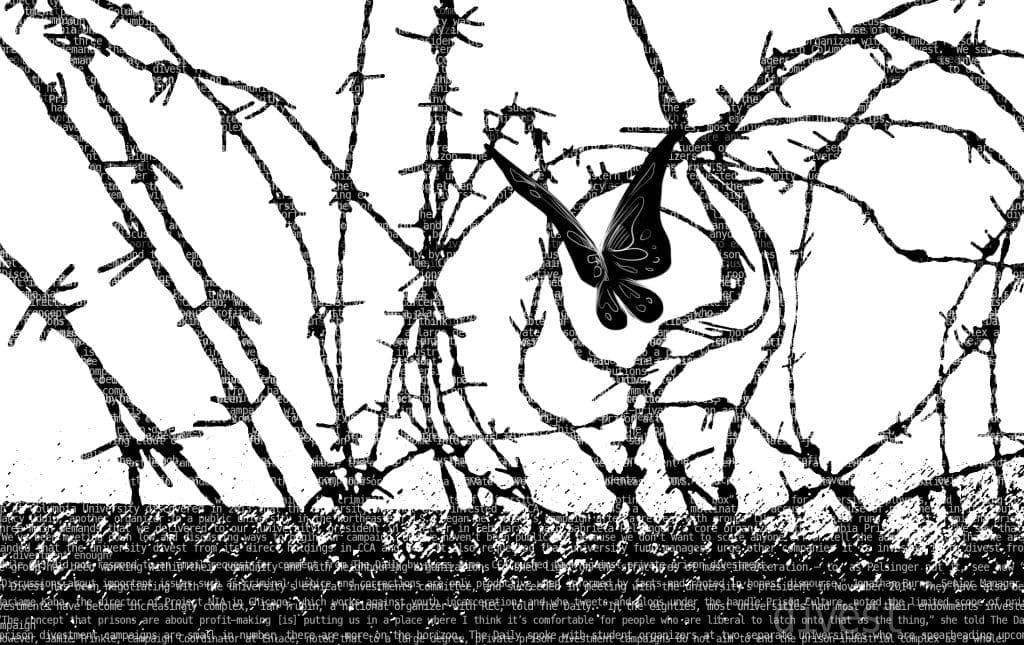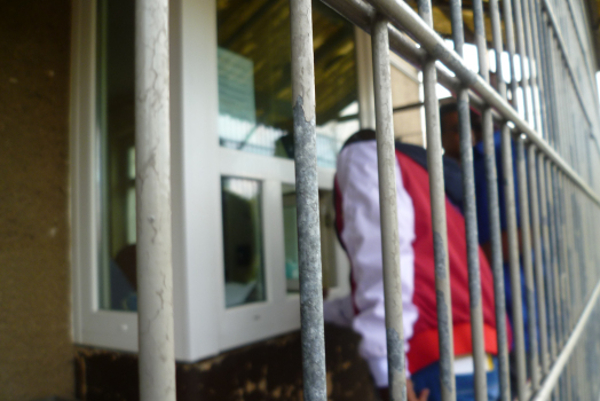Transcribed from the 30 March 2019 episode of This is Hell! Radio (Chicago) and printed with permission. Edited for space and readability. Listen to the whole interview:
Capitalism consists of these flows. People can understand the flow of oil through a pipe, and from there you can better understand how commodities flow through the state of Michigan and also around the world.
Chuck Mertz: I am oddly proud to say that my home state, the place of my birth, Michigan, has become the front line in a revolutionary way to confront and stop tar sands pipelines and the exacerbation of global warming. Here to tell us what’s happening in Michigan’s fight against climate change, Duncan Tarr and Noor us-Sabah cowrote the Commune Magazine article “The End of the Line: The rusting fossil fuel infrastructure of the upper Midwest connects the poisoned residents of Flint to the wreckage of Alberta’s oil sands. Can it also become the backbone for a new movement against planet-killing capitalism?”
First you, Duncan, welcome to This is Hell!.
Duncan Tarr: Thanks for having me.
CM: And Noor, welcome to This is Hell!.
Noor us-Sabah: Hey!
CM: Noor is from Detroit, Michigan, which is where I was born; and Duncan is from Lansing, Michigan, where I lived for five really shoddy years of my life.
Duncan, let’s start with you. You write, “Mapping the flow of oil helps make the climate crisis more legible, and helps us prepare for the conflicts to come.” How are we better prepared for the conflicts to come by mapping oil pipelines? How does knowing where oil pipelines are help fight global warming?
DT: We start with oil pipelines and where they are in Michigan. They’re marked by these little flags in the ground, and they’re marked every hundred miles by a pump station. We think this is useful. Maybe this is an aspect of pipelines that is talked about less often: the everyday struggle that property owners and people who live nearby and people who live downstream have to deal with; the company pressuring and harassing them, coming and doing construction, these sorts of things.
Above and beyond that, why it’s useful for us is that capitalism consists of these flows. People can understand the flow of oil through a pipe, and from there you can better understand how commodities flow through the state of Michigan and also around the world.
CM: Noor, you write, “The devastation wrought by a fissure in an oil pipeline is not an airy hypothetical for rural Michiganders. In 2010, a different Enbridge pipeline, Line 6B, ruptured and spilled one million gallons of corrosive tar sands oil into the Kalamazoo river in southeast Michigan.” So our listeners understand the level of this kind of threat, how does tar sands oil have a greater effect on the ability to clean up after a spill?
NS: Conventional oil sources are dwindling, the easy-to-extract drilling sources are now being replaced by harder-to-extract and -refine oil sources. Canada’s biggest oil source right now is tar sands. They basically squeeze oil out of sand, when before, in conventional oil sources, you would drill into the sand and find a pocket of oil and get it out like that. Now they’re squeezing oil out of sand.
That is not only extra difficult to extract and refine, it’s also heavier crude oil, higher bitumen levels. That’s going through certain types of pipelines, pipelines that aren’t built to hold that kind of oil, which is corrosive. Also, when those pipelines rupture—as they did in the largest inland oil spill in American history, in the Kalamazoo river, a very beautiful wetland and habitat—it has more devastating effects on the habitat there and the area there than the “normal” oil spills that, unfortunately, we are desensitized to accept happening regularly in this country.
CM: You also write that it is tar sands oil that flows through Enbridge’s Line 6B—tar sands oil that destroyed the Kalamazoo river. Just so people have a visceral understanding and an image in their mind of how badly the Kalamazoo river has been destroyed: how was the Kalamazoo river “destroyed” by tar sands?
NS: It’s hard to measure what restoration even looks like in that sense, because when it comes to these types of oil spills, the state of Michigan goes to the company that did it and says, “Okay, clean that up. You did this, and now you have to clean it up.” We’re trusting the oil companies themselves to tell us if it’s fixed, when the people who are living around these areas are suffering from medical issues, the water source has been polluted. The habitats are being restored by companies that are more skilled in pumping and drilling and transporting oil rather than actual ecological restoration.
It is hard to tell the vast impact of this spill on the habitats and the animals there.
DT: To add to that, when we’re talking about the river, one thing in particular about tar sands oil is that it sinks to the bottom of the riverbed. It’s exceptionally difficult to clean up. But we’re also not just talking about the river and the riverbed and the habitat. We’re talking about the people who literally died who were living along the edge of the river, as well as the classic scenario: those with more money could relocate more easily.
In particular there was a trailer park right along the Kalamazoo river, right near where the spill happened, and a bunch of those people in the years immediately after the spill got all sorts of cancers and other diseases. It’s hard to link directly to the spill, but when we’re talking about the Kalamazoo river being “destroyed,” we’re also talking about people who got really sick. We’re talking about lives that were destroyed, and not just a river, abstract from people or other animals.
CM: Duncan, how much say did the people who ended up being the “neighbors” of this pipeline have in the placement of the pipeline? Both of you write about the impact on Native American tribes, on Indigenous peoples’ areas (because they often go through Indigenous land). How much of a say did the people who are not Indigenous have in the placement of the pipeline, when they also ended up being the neighbors of the pipeline?
DT: When it comes to making these flows more legible, making the climate crisis more legible, in a sense these things are hidden processes that people don’t really have a say over. People do fight to have the pipeline not go through their land or not go through a certain wetland or not go through their reservation. Oftentimes those fights are lost, because the company not only has millions of dollars on its side and professional lawyers, but also the police and the state, and eminent domain and these sorts of things. As far as people having some sort of say where the pipelines go, I don’t think that’s really on the table.
If we don’t break with the logic of endless growth and the logic of capital, and we simply substitute (so-called) renewables, all we’re doing is displacing where the sacrifice zones actually are. The process to create solar panels and to mine all these metals to create windmills—they also really devastate local habitats.
People fight these things quite actively and they lose, or they don’t even know and they buy property and there’s a pipeline running through the stream in their backyard or through their farmlands. That’s the other side of this. It’s sort of hidden—it’s literally underground. So when we’re talking about mapping it, we’re talking about making it more legible, making it visible, making it something people can actually see and think about.
CM: Noor, you and Duncan also cite a study by Oil Change International stating “Canada can’t increase tar sands production or build more pipelines if the world is to achieve the targets on global carbon emissions set by the Paris agreement on climate.”
Can Canada’s tar sands production, all by itself, undo the Paris climate convention accord? If so, Noor, what does it say about the accord if one nation’s fossil fuel production can undermine it? Or, for that matter, what does that reveal about Canada’s production? Is this a matter of massive production or weak accords?
NS: There are competing issues here. There are people who are interested in accommodating these accords, but that’s not possible if they want to increase their production. What we’re hearing more, without even talking about the accords, is that it’s an issue of national security and national economic security. In Canada most of the discussion is about how Canada’s oil industry is suffering because of these anti-pipeline campaigns, and that there’s a bottleneck of oil being shipped out of Canada into other places, and of its transfer to the Gulf for refining.
People are talking less about whether we should increase or decrease oil sands production, tar sands production, in Canada and more about how we solve these bottlenecks in the Canadian oil industry. Enbridge is suffering! How can we save them?! That’s more what we’re hearing.
It’s not even just about the tar sands oil in Canada, but also crude oil in the Bakken oil formation in North Dakota. The same oil that is taken through the Keystone pipeline, through the Dakota Access pipeline, through the Bayou Bridge pipeline—these are crude oil formations that are being extracted from, and while the discussion is on the economic security of the oil industry in Canada, it should also be connected to the effects of the crude oil in the US as well.
CM: Duncan, you write, “Without a break from capital, if it’s not a wasteland in Athabasca in northern Canada, it’s a wasteland somewhere else—in the Congo, perhaps, or in Chile or Central China, where the minerals necessary for renewable energy are mined. Even those reforms which would aim to abolish fossil fuels entirely won’t stop capitalism from creating new sacrifice zones, areas of the planet rendered largely uninhabitable.”
Is the problem that the public is simply not aware enough of these sacrifice zones? That we don’t see the damage that is wrought by climate change? You know those pictures of diseased lungs on cigarette packs, or even just the written surgeon general’s warnings—should we have pictures at gas pumps and docking stations of the devastation caused by drilling for oil or mining for lithium? And do you think that would have any impact?
Do you think it’s just a matter of people being better informed about the sacrifice zones, and that would change our understanding of global warming?
DT: That’s a fun proposal. It would be an interesting social experiment, but I don’t think fundamentally that is the revolutionary change needed to adequately address these ideas. We talk about other types of sacrifice zones as well. We talk about the Athabasca oil sands—but the proposal from many on the left is to hold on to capitalism, hold on dearly and tight, and we’re just going to replace our current energy infrastructure based on fossil fuels with solar panels and other sorts of renewable energies.
If we don’t break with the logic of endless growth and the logic of capital, and we simply substitute (so-called) renewables, all we’re doing is displacing where the sacrifice zones actually are. The process to create solar panels and to mine all these metals to create windmills—they also really devastate local habitats. That’s a critique we offer in the article, even of proposals like the Green New Deal, which has a lot of momentum right now: we don’t accept that that’s going to keep so many of the structures and processes that currently operate in that world, and keep it the same.
NS: It’s interesting to think that for these different types of environmental issues and human rights issues and environmental justice issues, people are talking and focusing on different problems with it. When we’re talking about these oil pipelines and energy sources as being devastating to the environment, there’s a focus on the environmental issues and not as much focus on the impact on disadvantaged communities and the human issues related to that.
When we’re talking about increasing solar panels and increasing wind turbines and those kinds of renewable energy sources, the focus is just going to be on how that’s environmentally more sound, when we’re not talking about how a lot of these minerals are sourced from very messed-up areas, how they’re conflict minerals, and there are human rights abuses to get these minerals. How do we balance all these interests?
CM: Noor, how can we get to what you call the “radical and necessary goals of abolishing the fossil fuel industry” in consultation with civic groups and business, that could reach one hundred percent of national power generation from renewable sources by 2030, as the Green New Deal promises—how can we reach those goals without producing an alternative energy source that could lead to re-industrialization? How can we reach what you see as laudable goals of the Green New Deal without creating an alternative fuel as substitute for fossil fuels whose very production could lead to another industrial age?
NS: That’s a difficult question. It’s important while we’re talking about these issues to make a more radical discussion that’s talking about a larger break from the current paradigm and structure of capital. When we’re talking about a Green New Deal and completely changing the energy sources and how that would impact industrial processes, we have to equally and as fervently be talking about how we are going to stop re-creating these sacrifice zones in other countries, and how we’re not going to just be solving American environmental issues while sacrificing the livelihoods of people in other areas, and rights to autonomy and self-determination in their own communities.
The beauty and terror of capitalism is that it is constantly evolving. It is a machine that will continue to turn unless we take it over and try to do something else with it.
CM: Duncan, you write, “On the other side of the Detroit river, a leg of the Enbridge pipeline system called Line 9 has been disabled multiple times. For example, pump stations are located above ground along the route of the pipeline at regular intervals, and can be disabled by simply turning a wheel. This valve-turning tactic has since been repeated elsewhere as information about pipeline resistance gets disseminated.”
Duncan, how long do the pipelines remain disabled in this valve-turning tactic?
DT: The exact details are a little bit hard to discern, but they are apparently turned off until the company goes and turns it back on, or the police, or something like that. But with some of these protests, people announce their intention ahead of time, and sometimes the pipeline operator turns off the flow preemptively to prevent any sort of disruption. It’s hard to tell, but if you turn it off, it’s off until you turn it back on. It usually ends up being a couple of hours before the company can get down there and turn it back on.
CM: Noor, is this kind of disabling illegal? Are people being arrested for this kind of disabling? Or is it really easy to get away with?
NS: Absolutely people are getting arrested for this. But it depends. If you’re trying to focus on extending the amount of time it stays off, a lot of people we’ve seen have been chaining themselves to these pump stations, making a blockade so people can’t come and turn it off sooner. That is them possibly putting their lives on the line, and definitely getting arrested, and dealing with the repercussions of trespassing or paying a restitution to the companies for causing them financial loss.
Still, depending on the security of different types of pump stations, you could go do it in the middle of the night, turn it off and run away, and not be seen.
CM: So this is a combination of valve-turning and barricades? Are these strategies that are new in Michigan that are being applied elsewhere? Are they strategies that were taken from other protests like Standing Rock? Where did this tactic come from? Is this brand new in Michigan?
NS: It has mostly been done on the other side of the river in Canada, people in Ontario. Environmental tactics in general, in regards to blockading, have been a lot more influenced by things like sit-ins around the civil rights era. Those things have been adapted to environmental tactics, and more broadly towards Indigenous rights tactics. We’re building off this history of resistance. These tactics aren’t necessarily new, they’re just being adapted to certain movements.
CM: So Duncan, the next stage in this—I think it’s already underway—is going to be Line 5. Enbridge Line 5 is going to be a tar sands pipeline that goes through the Mackinac straits, the straits that link Lake Michigan to Lake Huron, in the largest area of fresh water anywhere in the world. How dangerous is it that Enbridge is building this pipeline? What could happen to Michigan’s and the world’s fresh water supply if there’s a spill?
DT: It would be absolutely devastating. This is why the consensus among a broad range of the political spectrum in Michigan is that this would be devastating—the rightwing business owners up there are also against this pipeline. Just a small point—it’s not a tar sands pipeline, but it is crude oil and liquid natural gas.
Our article is responding to some of the political maneuvering happening in Michigan around this. The governor is a Democrat who just won, Gretchen Whitmer; this is something that she ran on. She wanted to decommission Line 5, and that’s great. That would make it a lot safer. But the fact of the matter is if we can’t challenge not only Enbridge the corporation—which is going to continue to try to ship oil—but also the logic which we keep coming back to that requires oil for perpetual growth, if we don’t challenge the root cause, capitalism, then they’re just going to ship the oil some other way. They’re going to ship it via truck or via train, and the trains are going to explode.
So it’s great if Line 5 is out of commission, which it might be in the next two years, if the governor keeps going the way she’s going. But it just geographically shifts the problem.
CM: Noor, can we save the planet and save capitalism? And what happens if we try to do both?
NS: Capitalism—the beauty and terror of it is that it is constantly evolving. It is a machine that will continue to turn unless we take it over and try to do something else with it. I think “smashing capitalism” is too big for my liking. I’d rather change the nature of it, while saving the planet.
CM: Duncan, you point out how the United States’ biggest trading partner is Canada; all this trade going through Michigan goes through Detroit. Detroit, where I was born and where I lived for a while, is getting better but it’s an economically devastated city. Michigan is not in a very good financial situation. What does it say about the way our economy works, the way that capitalism works, when the biggest trading partner sends most of their trade through Michigan, yet Michigan is still financially devastated?
DT: That speaks exactly to the problem we’re describing, which is that we live in an economic system in which the benefits and the profits of the economy are going to a small number of people and a small number of corporations—and it’s going in huge amounts. It makes total sense that Michigan is becoming this shipping corridor that isn’t actually benefiting most people in Detroit, and it’s not benefiting people in Flint, it’s not benefiting people who live along Line 5. It’s benefiting corporations that are developing Detroit, that are operating oil pipelines, that are building bridges.
You’re describing the problem of capitalism, and that’s exactly what we wanted to get at and think through in our article.
CM: Duncan and Noor, I really appreciate both of you being on the show today.
DT & NS: Thank you.
Featured image source: Commune Magazine





